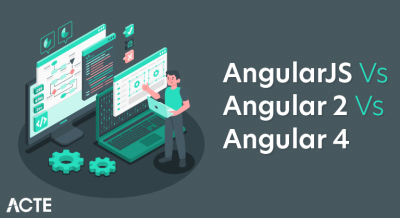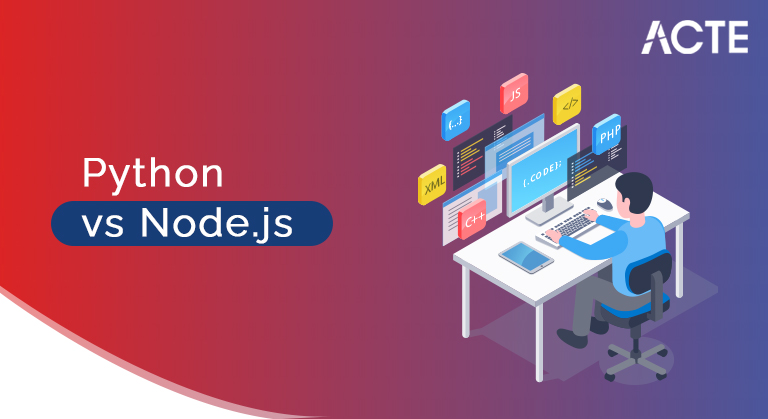
Node. Js is a server-side platform built on Google Chrome Javascript Engine whereas Python is an object-oriented, high level, dynamic and multipurpose programming language. Node programming language is best suited for asynchronous programming whereas Python is not the best option for asynchronous programming.
- Node.js vs Python: Overview
- Node.js vs Python: Which one is more popular?
- Node.js vs Python: Detailed Comparison
- Learning curve & Syntax in Node.js vs Python
- Architecture in Node.js vs Python
- Performance & Speed in Node.js vs Python
- Libraries & Dev Tools in Node.js vs PythonCommunity in Node.js vs Python
- Community in Node.js vs Python
- Extensibility in Node.js vs Python
- Data Processing in Node.js vs Python
- When to use Node.js over Python: Use Cases
- When to Use Python on Node.js: Use Cases
- Features of node js vs Python
- Conclusion
- On the other hand, Python is a full blown, high-level and object-oriented programming language. Since it’s been around for 30 years, there are a tonne of libraries, APIs, and accessories available. Python is adaptable to many programming paradigms, and is widely used for business applications.
- Its community, library and supporting forums are far-reaching. Therefore, it is an ideal programming language for most businesses that need to develop applications for various and often unrelated use cases.
Node.js vs Python: Overview:
The key difference between Node.js vs Python is that the former is a runtime environment that mainly relies on Javascript. It is used for applications that frequently interact with web servers and is designed for optimal computing-resource usage.
What is node.js?
Since Node.js is event-driven, it is scalable and brings unprecedented capabilities to the project. Its asynchronous nature equips it to handle concurrent requests without blocking I/O operations. Most development teams prefer Node.js to use JavaScript both on the client- and server-side.
What is Python?
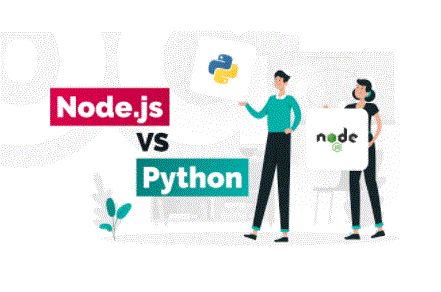
- The popularity of backend technology plays an important role in whether it will be used for your project or not. First of all, from the company’s point of view, the development team has to decide which language has enough talent available in the market. And then from the programmer’s POV, a decision has to be arrived at whether they are willing to take the languages that are mainly used by many companies.
- Looking at the popularity of websites, SimilarWeb reports that Node.js was previously credited with the most used tools in the 10,000, 100,000, 100,000, and ‘entire’ categories of websites based on their popularity. place was given.
- According to the Stack Overflow 2019 survey, Python was the most liked programming language, while Node.js was the most preferred tool among professional programmers.
- Reviewing the industry-wise adoption, Node.js has been the leader in computer electronics & technology, lifestyle, arts & entertainment and 16 other categories as per the survey. Whereas, Python is a popular choice in science and education, engineering and many other industries.
Node.js vs Python: Which one is more popular?
Node.js vs Python: Detailed Comparison:
Scalability is the linear increase in resource requirements as you scale your web application. Initially, when you create an MVP, you will have a lightweight web application and practically any language/coding environment will work for the task. However, as you scale the application with features and functionalities, the resource consumption of the language/coding environment will also increase in proportion.
Node.js:
Node.js gives you enough flexibility to avoid core. That way, instead of building a single core and then scaling everything around it, you build a set of microservices and modules. When your application scales, these microservices and modules can dynamically run their own processes. Therefore, you can scale the app horizontally by adding existing nodes and you can expand it vertically by adding resources.
Python:
Python has problems with threads. It is built on the Global Interpreter Lock, which does not allow it to operate on multiple threads simultaneously. This means that you cannot sequentially run another process before the historical process is finished. Although Python is dynamically typed, it has a drawback in terms of scaling. Large teams can find it difficult to maintain code when the project scales. Given the flexibility and low maintenance, Node.js is certainly more scalable than Python.
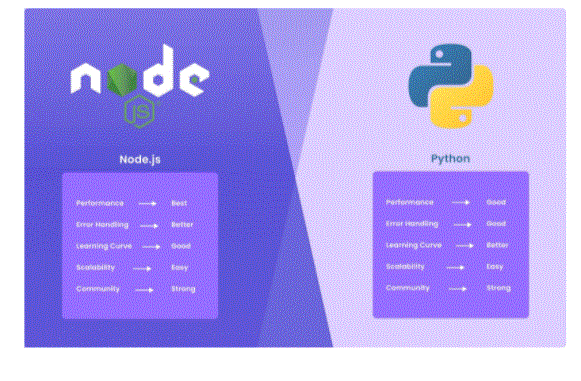
- If you are already familiar with Javascript, the learning curve for Node.js is not that steep. Some people consider Node.js to be a bit difficult to set up and document because of its event-driven programming concept. This concept is the major reason why Node.js is scalable and efficient.
- However, if you are a new developer, you may need some time to fully conceptualise event-driven programming. But once this is taken care of, there is practically no barrier to learning Node.js.
- The USP of Python has been its universality and easy syntax. It is an industry-wide fact that the code length in Python is relatively short as compared to Node.js or other programming languages and runtime environments. Writing code in Python is very simple.
- A major issue with both languages is that they are sensitive to indentation and whitespace. As a new developer, you will be making these two errors over and over again, and resolving such errors can be quite difficult.
- It is easy to adopt both languages. But based on what you already know, one will be easier than the other. If you are familiar with JavaScript, it doesn’t make any sense to use Node.js. If you’re new to programming, Python will discipline you on indentation and whitespace, but will also give you enough room to build applications using its easy-to-use syntax. So let your requirement choose for you!
Learning curve & Syntax in Node.js vs Python:
‘Syntax’ refers to the efficiency of a language/programming environment to execute a set of functions with a few lines of code. This is achieved by packing popular functions into inbuilt functions. It’s not hard to assess how this relates to the language learning curve – the smoother the syntax, the flatter the learning curve.
Node.js:
Python:
- Unlike Node.js, Python does not provide such functionality and does not support multithreading. You must run and terminate one process before the others can be called. This makes Python a bit harsh.
- Although there are some tools that can help you build asynchronous apps using Python, they don’t make Python inherently asynchronous. You will end up using workarounds in the project and not really achieve the desired asynchronously.
- This rounds up to Node.js, thanks to its more receptive and friendly architecture.
Architecture in Node.js vs Python:
The architecture defines the common practice/principles for the framework/environment or language to follow. Nodejs has a single-threaded architecture, which handles multiple requests with a single thread. In contrast, Python follows a standard implementation called “cpython” using interchangeable code modules.
node.js
As we saw earlier, Node.js is a runtime environment with server-side asynchronous programming. This means that the input-output functionality is not blocked because a certain process is still running.
You can run parallel processes – deploying applications faster. Its event-driven architecture allows Node.js to take action when an event occurs.
Python
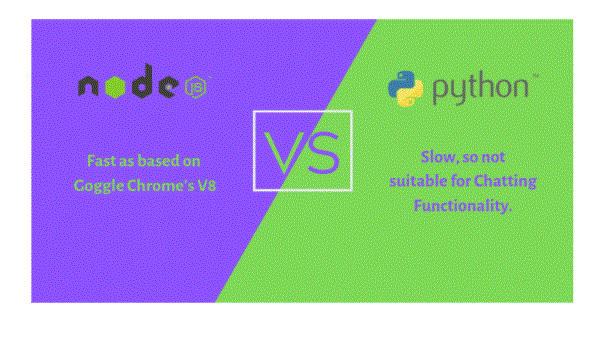
- We have already explored Node.js non-blocking architecture. With this advantage, its execution process is simple and fast. On top of that, there’s still another advantage that makes Node.js a solid contender – it executes code outside of the web browser.
- In this way, the app running on the web-browser is processing at a faster speed and as a result performs better on efficiency metrics. This allows the app to pull in features such as TCP sockets, which are otherwise not available in the browser.
- Python’s intuitive architecture prohibits multithreading and there is a problem in this aspect as well. This slows down the processing speed as the processes do not run in parallel.
- While Python’s syntax is easy to learn and execute, it is not fast enough for applications that frequently memorise data from web servers. Python’s syntax is easy to learn, but it is not optimised for speed and performance. Node.js is the clear winner here too.
Performance & Speed in Node.js vs Python:
When you’re scaling an application, every single bit of efficiency helps reduce operating costs. Therefore, performance and speed are considered important when assessing a programming language or environment.
node.js
Python
Libraries & Dev Tools in Node.js vs Python:
Libraries are the reason app-development technology has evolved so much over the past few decades. The concept is simple – if something is already designed as a code, you shouldn’t have to recreate it. Instead, you should be able to integrate this code directly from the library into your program, while you’re only writing code for the features you want to build. However, the size or width of these libraries alone is not enough. You’d better also look into the documentation available to fully utilise a language’s library.
node.js
Node.js actually has extensive and well documented libraries managed by the node package manager. With 350,000 packages, npm is the largest repository of packages in the world.
Python
Python’s libraries are managed by pip – an acronym for ‘pip install package’. It is an industry observed fact that Python libraries are well documented and easy to deploy. While this is largely true, it is not the case with newer libraries. Newer technologies are often not as well documented as older ones – making newer libraries a little less reliable.
Community in Node.js vs Python:
A community is a group of users and developers engaged in technology. Since they are active, they will keep updating popular libraries, running debugging exercises, and even adding new features. Generally, the most effective communities are those that are managed by a single, dedicated organisation for the language/programming environment.
Node.js’ community
You may view Node.js as a relatively new technology and consider its community to be small. However, you will be surprised to know that the Node.js community is quite large and active globally with experienced Node.js developers. Finding talent in Node.js circles is very easy.
Python’s community
Python, being the older language of the two, naturally has a larger community. From junior to senior level contributors, Python has no shortage of talent. One of the biggest benefits of having such a large community is the ease of finding developers. And the active participation of these developers results in quick fixes and overall improvement of the language.
Both languages are on the rise and have a global contribution to their tech stack. They are open source and free to use. Therefore, choosing one over the other just for the availability of talent and community support should not factor into your decision.
Extensibility in Node.js vs Python:
The extent to which you can add features to a language by using third-party tools is its extensibility. More extensibility in third-party tools would simply mean that the language could be modified with additional features. Therefore, it is important to look at this aspect when considering Node.js or Python.
node.js- Node.js can be combined with Babel for better front-end development if you are using older versions of it. You can also use Jasmine for unit-based testing or Log.io to manage the project. Webpack and PM2 can help you with module bundling whereas Express is one of the common frameworks used with Node.js.
Python- Sublime Text is often used with Python to edit code. Robot Framework helps in automated testing. And then there are popular Node Js frameworks like Django and Web2Py, which add a load of features.
Universality in Node.js vs Python:
Today, a web application can be accessed through as many devices as there are fingers on one hand. With such diverse paths, it is only natural that the language/environment of development should be equally sophisticated.
node.js- Node.js performs very well on this front as it is usable for both backend and frontend development for JavaScript. Be it websites, web applications, desktop applications, mobile applications, or cloud and IoT solutions – Node.js is an all-rounder!
Python- Python’s simple syntax makes it suitable for all types of projects except a mobile app. For IoT solutions and cloud apps, Python is being used more and more by a large number of programmers.
Error handling capabilities in Node.js vs Python:
There is nothing quite as satisfying as error free code. Therefore, the language in which the error-handling process is the best is always the preferred choice for the CTO.
node.js- The parallel-process running feature of Node.js can make finding bugs and errors in code a difficult process.
Python- Python’s simple syntax and lack of parallel processes come in handy when scanning the code for bugs and errors.
Data Processing in Node.js vs Python:
This may seem like an insignificant aspect, but it deserves due consideration. Improved data-processing power automatically makes a language/environment more efficient and adoptable.
node.js- If the use case of your app is data intensive, then your preferred choice should be Node.js. The technology provided by the runtime environment makes it ideal for apps where data is transmitted and handled quite frequently. Parallel running and seamless I/O operations make Node.js the more efficient contender here.
Python- With a simple syntax and only one thread running at a time, Python is relatively slow to process data.
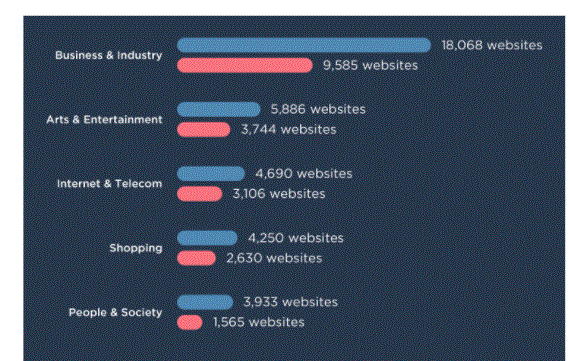
- Node.js is the runtime environment that is ideal for applications that require a coherent connection between the server and the browser-side app. For example, take a chatbot – if it is not connected to the server seamlessly, it will not be able to perform server operations to answer customer queries.
- A simple way to think of a need for Node.js in an application is by ranking the real-time features for the app. If real-time data transmission is critical to the usability of the app, then Node.js is exactly what you need.
- It’s also worth mentioning that Node.js can be used both on the server and on the client side. This will reduce deployment time and make it possible for teams to maintain code while coordinating.
- Due to its efficient processing, Node.js is the go-to platform used by companies that constantly interact between cloud servers and client-side applications. Netflix, LinkedIn, Medium, Trello and PayPal are some of the well-known tech companies that use Node.js for their platforms.
- Python has the widest availability of brilliance partly because it runs on a simpler syntax. So it’s no surprise that Google and Facebook, the two biggest technology-genius consumers, use Python extensively to build technologies.
- In addition, some of the most popular data-science training courses use Python as the default language taught to students. As a result, the availability of Python talent is increasing.
- Furthermore, the popularity of Python makes it a strategically important language to learn and use. Its rich libraries allow you to build and deploy an MVP very efficiently. It also ensures that developer resources are optimally utilised.
- For example, Reddit was originally written in Lisp, but the entire platform was rewritten with Python in 2005 due to its extensive list of features and libraries.
- There’s more! The Python interpreter—responsible for executing the code—is super effective. It does not require compilation, and this makes Python the ideal language for rapid deployment and iterations.
When to use Node.js over Python: Use Cases:
When to Use Python on Node.js: Use Cases:
- It uses a single threaded model with event looping. This type of event mechanism benefits the server to respond in a non-blocking manner.
- It is built on the V8 JavaScript engine which makes it the fastest code execution library.
- There is no buffering in Node.js because applications output data in chunks.
- This allows low-level modules to be included in the Python interpreter. These modules allow programmers to add or customise their own tools.
- It provides an interface to all major commercial databases.
- It supports functional and structured programming methods as well as OOP.
- It provides high-level dynamic data types and supports dynamic type checking.
- It can be easily integrated with C, C++, COM, ActiveX, CORBA, and Java
Features of node js vs Python:
Features of node js.
Features of Python:
Conclusion:
Choosing between Node.js and Python can be tricky, especially when you want to develop a full-flagged product, not just a side-project. The features and benefits of both sides can be overwhelming and cloud your judgement.
Therefore, the ideal way to tackle this dilemma is to focus on the end use of your product. List all the features of your product, and how you plan to produce them. And the language or runtime environment that proves to be more useful should be your choice.


